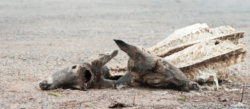We have seen the discarded rib cages and carcasses of dead elk, deer, and antelope. Usually they are dumped on public land and accesses. The bones have been picked clean. Antlers, Ivories, and horns removed, along with any identification of the thoughtless, selfish, and lazy dumpers.
I am sure that if their trash ended up in their front ditch or yard, they would scream Bloody Murder. This NIMBY mentality, “not in my back yard”, selfish mindset needs to change.
Dumping carcasses can spread CWD and other diseases. Not to mention issues when pets get into the carcasses. Discarded, contaminated carcasses can spread disease for at least 2 years!
Proper Carcass Disposal is not hard. Simply put it into your own trash can for the regular garbage pickup. If your can is full, ask a neighbor for use of theirs. This added organic nutrient is not harmful in a landfill. The nutrients will help to decompose other landfill materials.
You can also bury a carcass and cover it with at least 18-24 inches of soil. This will accelerate the decomposition of the carcass naturally. Observe the area in case other critters begin to dig the burial up.
Some landowners burn or incinerate dead carcasses. This will sterilize any contaminates. Normally this procedure is used with farm critters after butchering or a disease outbreak.
When people see discarded carcasses, they immediately blame Bloodthirsty Slob Hunters. This makes all hunters look bad. Hunting is already an unpopular sport to many non-hunters. Proper carcass disposal is simply an important responsibility that promotes health and keeps our country, and local herds clean.
Follow the law and help prevent CWD!
Montana Grant
For more Montana Grant, find him healthy at www.montanagrantfishing.com.